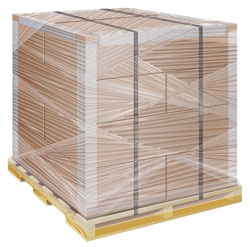|
|
Select your destination country above to calculate international shipping costs from the U.S.
Palletizing and crating in shipping goods from the USA internationally
Most of the time, cargo transporting from the USA overseas needs to be palletized.
During international cargo transportation, palletized and shrink-wrapped items are handled by forklifts for safe delivery. While you can ship 3 to 5 loose items overseas, heavy or oversized cargo must be palletized for shipping overseas.
Click the picture to watch a video on palletizing boxes for shipping from the U.S. abroad.
Palletizing your cargo offers several advantages, but it also has some disadvantages.
Here are the advantages of palletized cargo:
- A forklift can handle palletized cargo, increasing its chances of reaching its destination without damage or loss.
- All items on pallets are kept together, ensuring no partial losses for palletized cargo.
- Palletized cargo is protected from unauthorized access, theft, and other risks because it is shrink-wrapped.
However, additional freight costs may be incurred due to "dead volume" in palletized cargo transportation.
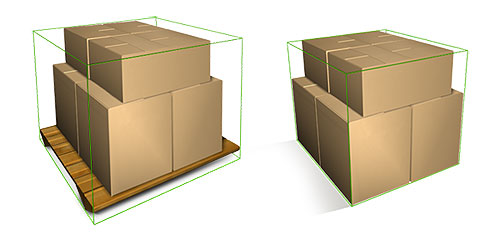
Palletization incurs additional volume-based charges, but it's often worth it for safer and more affordable international shipping. Letting an experienced international shipping company handle palletization helps avoid errors and ensures regulatory compliance. Ocean freight carriers typically do not ship unpalletized cargo internationally from the USA.
Shipping loose boxes
Typically, you can ship a few boxes loose. You can ship regular cardboard moving boxes of different sizes. However, if you send boxes loose, we recommend heavy-duty cardboard boxes for extra protection. Order online in advance. We may recommend Uline.com.
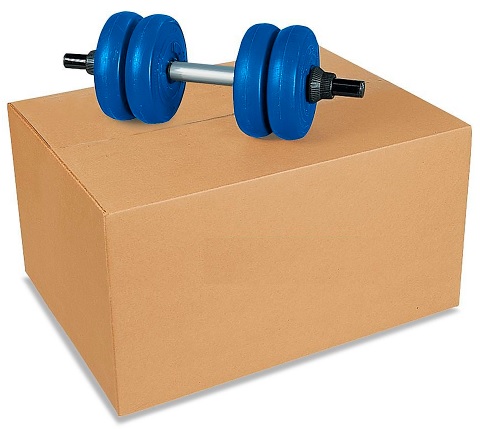
Shipping goods in loose boxes overseas has both pros and cons.
Advantages: A key benefit is avoiding extra costs for “dead volume.” Freight charges are based on the total volume of individual boxes.
Disadvantages: Transporting many small loose boxes using Less Than Container Load (LCL) isn’t safe. Each box is handled manually, which increases the risk of damage, loss, or theft during transport.
If you ship three to five boxes, you can request that they be shipped loose. However, for larger shipments or items over 100 lbs, the carrier’s terminal may require palletizing the boxes, even without a request.
Shipping overseas palletized cargo.
A standard U.S. pallet measures 48 inches (1.2 m) by 40 inches (1.0 m) by 6 inches (0.15 m). When pallets are loaded with goods, they are often referred to as "skids."
Loose cargo must be palletized into skids at an ocean freight carrier's terminal (Container Freight Station or CFS). Each skid should hold as many boxes as possible, but the height should not exceed 60 inches (1.52 m). The height depends on the boxes' strength, weight, and size. After packing, skids should be shrink-wrapped with plastic film.
Many sizes and types of pallets are used for international shipping from the U.S. Pallets must be easy to handle with forklifts. The bottom of the pallets should have at least 3.5 inches of clearance for pallet jacks to operate smoothly. Assembled skids should also fit into a 40-foot sea freight container.
If you are palletizing your items for international shipment, follow the wood packing rules (ISPM 15) that apply to all cargo leaving the United States.
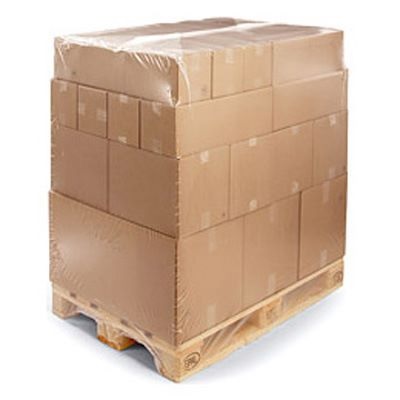
Shipping goods internationally using pallets has numerous benefits, although it also has some disadvantages.
Benefits: Palletized cargo is less likely to be damaged or lost during transit. When handled correctly, forklifts can easily move pallets. The items on pallets are securely fastened together, which greatly reduces the chance of losing part of the shipment. Palletized cargo is also better protected from unauthorized access and theft throughout the shipment process.
If you deliver loose items to a Container Freight Station (CFS), they will palletize and shrink-wrap your items for you. Palletizing costs usually range from $35 to $50 per pallet, which includes the fee for a certified pallet from the CFS. It is better to let the professionals at the CFS handle palletization instead of doing it yourself. Delivering loose shipping boxes is simpler to handle.
By letting the CFS palletize your cargo, you also transfer the responsibility for ISPM 15 compliance to them. This means you shouldn't face any issues related to ISPM 15 when shipping cargo from the USA.
** DISADVANTAGES:** You may incur additional freight charges for palletizing. This includes:
- A fee for the cost of the pallet(s) and the labor involved
- Additional chargeable volume, known as "dead volume"
If your cargo requires palletizing and the CFS cargo recipient is not aware of it when you deliver, don’t worry. This usually happens because the employee hasn’t yet received the work order for palletizing.
Submit your items and ensure that the cargo recipient records the number of boxes you submitted on a copy of your dock receipt. They should date and sign it. Keep this copy as proof of your delivery.
We will confirm the work order once you get a warehouse receipt from the CFS. Your goods will be palletized correctly, and we will notify you accordingly.
Chargeable cargo volume estimation
 For example, a skid with the largest size of 40 x 50 x 50 inches equals a ship of 1.65 gross cubic meters, or 58 gross cubic feet, regardless of the size of the boxes.
For example, a skid with the largest size of 40 x 50 x 50 inches equals a ship of 1.65 gross cubic meters, or 58 gross cubic feet, regardless of the size of the boxes.GUIDELINES FOR PALLETIZING
-
Wood Packing Rules (ISPM 15): When packing your cargo for overseas shipping from the USA using wooden pallets, be aware of the wood-packing restrictions for international shipping. Labeling Your Shipment: Always label your items before packing them onto the pallets. Remove any old labels to avoid confusion. This will help identify your items if the pallet gets damaged during international transportation.
-
DO NOT WRITE ANYTHING ON YOUR BOXES OR PALLETS about the commodity inside the boxes. You will provide commodity descriptions in your commercial invoices or valued packing lists. Then, it will be submitted to your shipment electronically.
-
SIZE AND WEIGHT: If shipping cargo from the U.S. using LCL, all units should not exceed 2,200 lbs by weight, 70" in height, 119" in length, and 80" in width. Otherwise, such cargo requires approval from the ocean freight carrier before it can be accepted for international transportation.
-
SAFETY ON LOADING AND STACKING BOXES INTO SKIDS: At the time of palletizing loose items for international transportation from the USA overseas, it is recommended to:
-
(1) Distribute weight evenly. Stack boxes squarely, corner-to-corner, against the skid's edge to maximize compression strength, but do not allow boxes to hang over the skid.
(2) Keep the top of the skid flat to minimize loss or damage to cartons; do not pyramid-stack.
(3) Place angled fiberboard (also known as angle board) between boxes to prevent crushing.
(4) Cover the top of the skids with plastic film to protect your boxes from weather damage during transportation from the USA to overseas destinations.
-
SECURING OF SKIDS: Wrap the skids in 70-gauge stretch wrap. Use at least two tightly secured bands to go through the skid voids and around all the cartons. If you can, use steel, rayon, polypropylene, nylon, or polyester strapping to secure the boxes. When bolting, use shock-absorber connections or cushioned skids, if applicable.
Shipping goods from the USA in crates
Crating goods for international transportation from the USA overseas can be quite costly. However, in certain situations, crating is necessary.
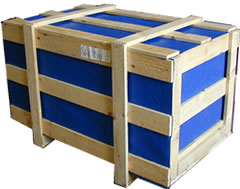
International transportation of valuable or fragile items abroad often requires crating. You can buy solid crates from packing companies or order them online.
It may be a good idea to hire a local packing company to crate your goods for international shipping from the U.S. Be sure to ask if they are familiar with international shipping regulations, particularly regarding wood packing restrictions.
When shipping from the U.S. using LCL (Less than Container Load), crates must be able to be lifted by a forklift and should fit easily into a 40-foot ocean freight container.
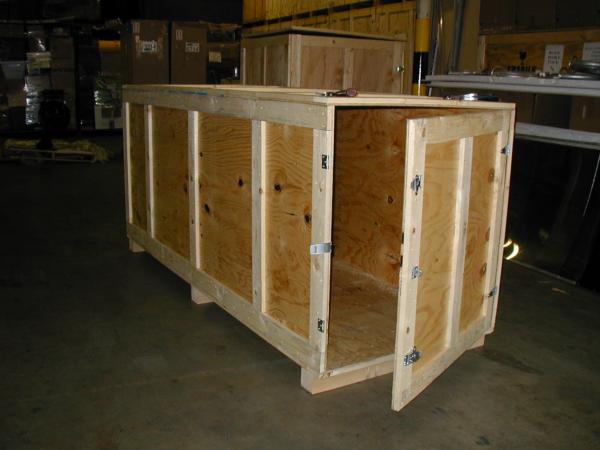
Mixing shipping units in transportation from the USA
When shipping goods overseas, consider using various types of shipping units. Utilizing the right combination of crates, pallets, and packaging can significantly reduce your international shipping costs. Use pallets and shrink-wrap for smaller items, crates for valuable or fragile items, and leave oversized items loose. This method helps keep your valuables safe and can lower international shipping costs when using LCL (Less Than Container Load) freight services from the United States.


.png)


